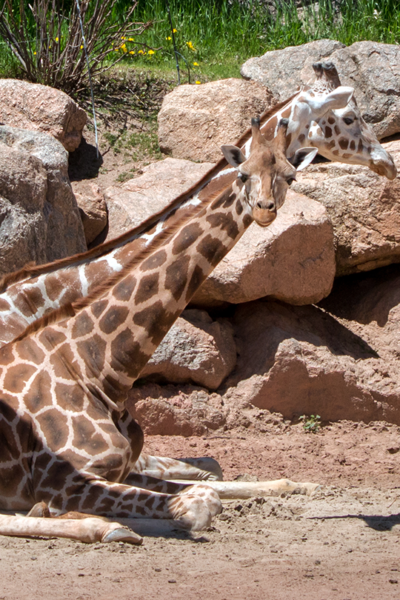In Partnership with Children’s Hospital Colorado
Some cuddle, some snore, some sleep on all fours. No matter how we do it, getting quality sleep is an important part of every healthy routine, whether you’re a human or an animal! Cheyenne Mountain Zoo’s partners at Children’s Hospital Colorado recently shared advice for parents considering what kind of sleep is best for their babies. There are lots of options for helping human infants sleep well, just like there are many different ways animals at the Zoo sleep!
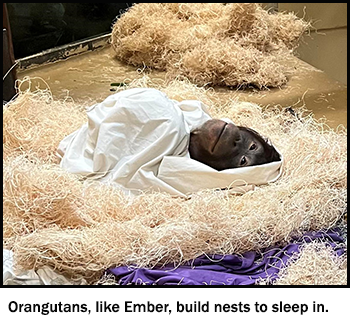
Orangutans might be the most particular sleepers at the Zoo. In the wild and in human care, they make new nests to sleep in almost every day. They usually assemble one nest for a midday nap and another more elaborate nest for their longer sleep at night.
To build nests at the Zoo, orangutans gather large amounts of bedding such as grass hay, wood wool, blankets, big paper bags and tree branches into a pile. Then, they sit in the center of the pile and pat, weave, rearrange, sort and layer the materials until their nest is just right. They typically build nests on the ground and on their tree-high platforms to sleep, but also rest in hammocks, big tubs or separate den rooms.
Young orangutans practice building nests for years before they start sleeping in their own nests as adults. Kera, CMZoo’s 4-year-old female Sumatran orangutan who lives and sleeps with her mom, Sumagu, practices nest building many times each day, but still shares mom’s nest to sleep.
“Orangutans learn by observing others, so Kera has watched Sumagu build nests since she was born and makes her own,” said Dina Bredahl, animal behavior assistant and longtime primate keeper at CMZoo. “Kera routinely flings her nesting materials to destroy her nest when she’s finished building so she can start all over again. Practice makes perfect!”
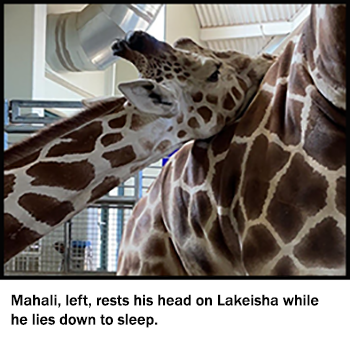
Like many humans aim to do, orangutans sleep for around eight to 10 hours a day. Tujoh, CMZoo’s 28-year-old male Northwest Bornean orangutan, seems to like the soothing sound of running water when he drifts off to sleep.
“We noticed that Tujoh would tinker with his drinking fountain each night until he made it run consistently,” said Bredahl. “So, we installed a small pool that circulates water and gives him the trickling water sounds that he seems to enjoy for a good night’s rest.”
CMZoo’s giraffe don’t need much sleep. They only rest or sleep for two to five hours a day! Most members of the tower only sleep for one-to-three hours at a time. Some giraffe stand up to sleep, others lie down and some do a combination of both.
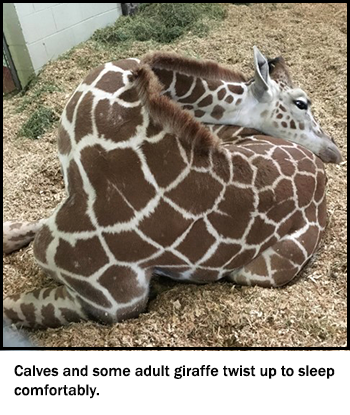
“The giraffe who lie down will twist themselves up into what looks like a big pretzel, and rest their heads on their hips with their legs either straight out or folded underneath them,” said Savannah Woods, African Rift Valley keeper. “I’ve also seen Mahali lying down to sleep and using Lakeisha’s back to rest his head while she’s standing next to him.”
They often sleep together in groups at night, but some take midday naps, like 4-year-old male Ohe, who can frequently be seen snoozing in the yard for a brief moment of shut-eye.
Big cats, on the other hand, sleep off and on for most of the day. Taking frequent cat naps allows them get plenty of rest while still maintaining awareness of their surroundings. Mountain lions sleep for up to 17 hours per day! They prefer cool, shady spots in the warmer seasons and sunny rocks during the cooler months. CMZoo’s mountain lions, Sitka, Adira and Koda, can often be found enjoying one of their heated rocks in the winter or the covered, cool spots under trees in their habitat in the summer months.
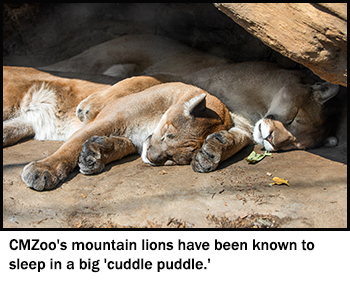
“Mountain lions are typically solitary in the wild, but have also been observed in social groupings,” said Courtney Rogers, senior keeper in Rocky Mountain Wild. “Our three mountain lions have been together from a young age, so they’re comfortable around each other and have become famous for their big cat ‘cuddle puddles,’ where they sleep in a big pile together by the glass guest viewing area.”
Mountain lions aren’t the only animals that sleep next to each other. Omo, CMZoo’s one-year-old Nile hippo, and his mom, Zambezi, often sleep in a big spoon, little spoon position. That’s only when they’re on land, though. CMZoo’s four hippos usually head to their pools around 2 a.m. to sleep the rest of the night away.
“Omo is getting more independent these days, but he used to use Zambezi as a raft when he was smaller,” said Al Carrier, Water’s Edge: Africa senior keeper. “They still rest their heads on each other sometimes. Hippos are really cool because they sleep mostly underwater and their instincts bring their noses to the surface to breathe every 5 minutes or so, without them waking up.”
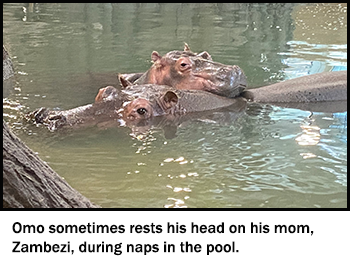
Each night, CMZoo’s hippos sleep for about 10 hours and nap for around another three hours during the day. Because they’re so large-and-in-charge, hippos are usually deep sleepers. If something wakes them up while they’re underwater, they can communicate through ‘hippo laughs’ that sound like a snort mixed with an old car horn, without surfacing, to let the rest of the pod know there’s a disturbance.
Wolves, known for their pack behaviors, also sleep near each other but rarely cuddle up once they grow out of puppyhood. That’s not an indication of a lack of bonds, though, for CMZoo’s pack of five Mexican wolves, Navarro, Shadow, Phoenix, Hope and Uno.
“When our wolves wake up in the morning after sleeping for much of the night, they greet each other with lots of face licks and wagging tails, even though they’ve been sleeping near each other the whole time,” said Rogers. “They seem to be light sleepers, always listening and smelling for potential danger. If one hears a noise and wakes up, they often will do a barking vocalization that can also alert the others.”
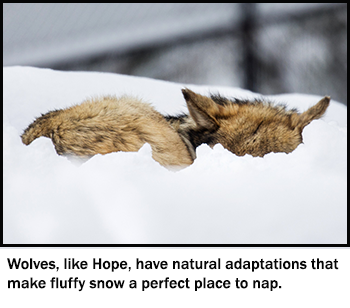
Wolves sleep around eight hours in a 24-hour period, usually lightly, with a long rest at night or after a big meal and with short naps throughout the day. Uno, CMZoo’s three-year-old female Mexican wolf was seen sleeping deeply when she was a pup, though.
“When they’re young, they often cuddle with their mothers,” said Rogers. “We would see Uno climbing up on top of her late mom, Luna, to sleep right on top of her in the den. She’s also the only one I’ve seen ‘twitching’ in her sleep, like dogs do. We can’t know for sure if she was dreaming, but it looked like she was running in her sleep, so maybe she was.”
Next time you’re at CMZoo, see how your sleep compares to the animals you visit!
